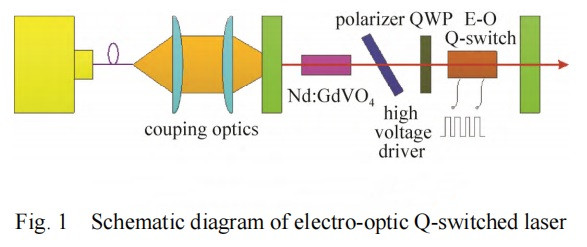1.1.2 LN E-O Q-swtiched laser
LN crystal is one of the few E-O crystals that has been practically used, and it has the advantages of large E-O coefficient, wide transmission spectrum, low insertion loss, and no deliquescence in air. Besides, LN crystal can operate stably in a wide temperature range. However, the piezoelectric ringing effect of conventional bulk LN crystal is severe, making its repetition frequency less than 1 kHz.
Researchers studied the difference in piezoelectric ringing effect of LN E-O crystals of different sizes. Small-sized LN crystals are used as E-O Q-switches in lasers, and the piezoelectric ringing effect can be ignored. The combination of low driving voltage and small size LN E-O Q-switch can finally obtain a laser output with repetition frequency of 15 kHz, single pulse energy of 238 μJ and pulse width of 5.4 ns.
1.1.3 RTP E-O Q-swtiched laser
RTP crystal has excellent electrical and optical properties, high resistivity and light damage resistance threshold; low driving voltage, easy to control, not easy to deliquescence, can withstand applied voltage for a long time. RTP crystal can work at high repetition frequency. There is no induced voltage effect with electrical signals up to 60 kHz. Latest data shows that the RTP Q-switch produced by WISOPTIC Technology Co., Ltd. has a maximum switching frequency of up to 1 MHz. RTP E-O Q-switch is composed of two crystals with same properties which are rotated 90° with each other to compensate for the natural birefringence effect of the RTP crystal.
In 2000, researchers used two RTP crystals as Q-switches in a Nd:YVO4 laser to obtain laser output with maximum repetition frequency of 75 kHz and a narrowest pulse width of 8.4 ns. This is a representative achievement of high repetition frequency RTP Q-switched laser.
In 2010, researchers used LD end-pumped Nd:GdVO4 and RTP Q-switch to obtain a pulsed laser output with repetition frequency of 100 kHz, single pulse energy of 79 μJ, and pulse width of 20.2 ns. The corresponding light-to-light conversion efficiency is 32.5%. The schematic diagram of this RTP Q-switched laser is shown in Figure 1.
In 2018, researchers used a RTP crystal pair as an E-O Q-switching element, and used 914 nm wavelength with low absorption coefficient to pump Nd:YVO4 to reduce thermal effect of the laser crystal. At repetition rate of 200 kHz, a single pulse energy of 80 μJ and a pulse width of 9 ns was obtained.
Post time: Sep-04-2022

